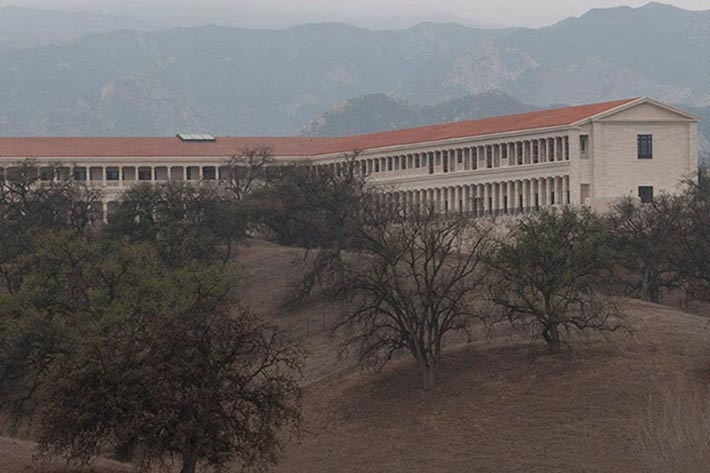
Vaults designed for storing nitrate film mix with Greek and Renaissance architecture in a building dominating the landscape in Santa Clarita, California. Discover it Saturday, April 21.
On Saturday, April 21, the Hollywood Section of SMPTE, the organization whose standards work has supported a century of advances in entertainment technology, will be guests of the Packard Humanities Institute and the UCLA Film and Television Archive for tours of the organizations’ PHI Stoa in Santa Clarita, California.
The first impression you get of the Stoa is that it is an architectural gem. The exterior has the form an ancient Greek stoa, with covered porticos. The interior is modeled closely on the 15th century Convent of San Marco in Florence. The architecture is not without meaning, and the mix of the two, not common (although I know of a similar case, at a Portuguese Museum), reflects the use given to the space.
The original Greek stoa, a type of building common in Greek towns, was a place to meet friends and discuss business, politics, or philosophy, and the Agora, or main square, had several stoas. The interior is modeled closely on the 15th century Convent of San Marco in Florence, a jewel of the Renaissance period, today a museum housing a famous collection of manuscripts in a library built by Michelozzo, the Medici family’s favourite architect.
So, following with the tradition of the original spaces it recreates, the Stoa is meant to serve as a quiet place where archivists and scholars work on preserving and studying films. The PHI Stoa, which is the West Coast complement to the Packard Campus of the Library of Congress in Culpeper, Virginia, continues, after all, the tradition of keeping knowledge for the future. In doing so it keeps with the Packard Humanities Institute’s (PHI) own tradition, as the non-profit foundation, established in 1987, and located in Los Altos, California, funds projects in a wide range of conservation concerns in the fields of archaeology, music, and historic conservation, plus Greek epigraphy, with an aim to create tools for basic research in the Humanities.
Film preservation is just one of the multiple projects the organization has had for a long time, and that in 2016 gained a new space, the PHI Stoa, the second largest audio-visual archive in the United States and houses the archival activities of both the Packard Humanities Institute and the UCLA Film and Television Archive. Its facilities include 120 vaults designed for storing nitrate film, and a larger set of vaults for safety films and other items, all strictly controlled for temperature and humidity.
There is a name behind all this: David Woodley Packard. The co-founder of Hewlett-Packard and president of the Packard Humanities Institute is responsible for what PHI Stoa is and what it represents. In an interview published by the Los Angeles Times in 2016, he says that “UCLA was looking for a modest little place to move to, and I got involved and turned it into something monumental. It’s a labor of love and a labor of craziness. I could have just built an adequate facility, but it didn’t cost that much more for it to be something wonderful.”
In the same interview David Woodley Packard, who is passionate for the traditional theatrical experience, comments how he broke a friendship with Steve Jobs, “when I told him movies were not meant to be seen on 21/2 -inch screens.”
“The Packard Humanities Institute and UCLA Film and Television Archive have built a magnificent facility dedicated to preserving our film and television heritage,” said SMPTE Hollywood chair Jim DeFilippis, announcing the tour. “We are very grateful to have this opportunity to visit the facility and meet the people who are engaged in this important work.”
Tours of the facility, available to SMPTE Hollywood members and others, will be offered at 10:00am, 11:00am, 12:00pm and 1:00pm. The tour is free for SMPTE members and nonmembers, but individual reservations are required. Space is strictly limited. A light lunch will be served.
